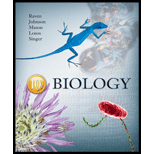
Concept explainers
Nonnative invasive species are often a threat to native species because they
a. typically grow larger than other plants.
b. are not susceptible to any diseases.
c. are
d. do not have natural enemies in their new location.
Introduction:
The invasive species can be defined as the plant, animal or fungus that is not the natural habitat of a specific location; however, they are introduced and spread to a greater extent. This greater expansion leads to damage to the environment and a threat to the native species.
Answer to Problem 1U
Correct answer:
The non-native invasive species do not have enemies in their new location and this account for threat to the native species. Therefore, option d. is correct.
Explanation of Solution
Reason for the correct statement:
The non-native invasive species poses more threat to the invasive species because the native species have natural attackers and enemies. The non-native invasive species are new to the location and hence, there is no threat of attackers for them. They possess a more risk because they lack natural predators in the new location.
Option d. is given as “do not have natural enemies in their new location”.
As, “the non-native invasive plants do not have any natural predators in their new environment, they possess a threat to the native species”, is the right answer.
Hence, option d. is correct.
Reasons for the incorrect statements:
Option a. is given as “typically grow larger than other plants”.
The size of the non-native invasive species does not possess a threat to the native species. So, it is a wrong answer.
Option b. is given as “are not susceptible to any diseases”.
The non native invasive species are the normal living organisms and they suffer from diseases. So, it is a wrong answer.
Option c. is given as “are parasitic”.
The non-native invasive species are not parasitic rather most of them are free-living. So, it is a wrong answer.
Hence, options a., b., and c. are incorrect.
The non-native invasive species are the plants, animals or fungus, which are introduced into a new environment and they are not the natural inhabitants of that location. They lack natural enemies in their new environment and hence, their growth rate are very high.
Want to see more full solutions like this?
Chapter 39 Solutions
Biology
- What symbolic and cultural behaviors are evident in the archaeological record and associated with Neandertals and anatomically modern humans in Europe beginning around 35,000 yBP (during the Upper Paleolithic)?arrow_forwardDescribe three cranial and postcranial features of Neanderthals skeletons that are likely adaptation to the cold climates of Upper Pleistocene Europe and explain how they are adaptations to a cold climate.arrow_forwardBiology Questionarrow_forward
- ✓ Details Draw a protein that is embedded in a membrane (a transmembrane protein), label the lipid bilayer and the protein. Identify the areas of the lipid bilayer that are hydrophobic and hydrophilic. Draw a membrane with two transporters: a proton pump transporter that uses ATP to generate a proton gradient, and a second transporter that moves glucose by secondary active transport (cartoon-like is ok). It will be important to show protons moving in the correct direction, and that the transporter that is powered by secondary active transport is logically related to the proton pump.arrow_forwarddrawing chemical structure of ATP. please draw in and label whats asked. Thank you.arrow_forwardOutline the negative feedback loop that allows us to maintain a healthy water concentration in our blood. You may use diagram if you wisharrow_forward
- Give examples of fat soluble and non-fat soluble hormonesarrow_forwardJust click view full document and register so you can see the whole document. how do i access this. following from the previous question; https://www.bartleby.com/questions-and-answers/hi-hi-with-this-unit-assessment-psy4406-tp4-report-assessment-material-case-stydu-ms-alecia-moore.-o/5e09906a-5101-4297-a8f7-49449b0bb5a7. on Google this image comes up and i have signed/ payed for the service and unable to access the full document. are you able to copy and past to this response. please see the screenshot from google page. unfortunality its not allowing me attch the image can you please show me the mathmetic calculation/ workout for the reult sectionarrow_forwardIn tabular form, differentiate between reversible and irreversible cell injury.arrow_forward
 Concepts of BiologyBiologyISBN:9781938168116Author:Samantha Fowler, Rebecca Roush, James WisePublisher:OpenStax College
Concepts of BiologyBiologyISBN:9781938168116Author:Samantha Fowler, Rebecca Roush, James WisePublisher:OpenStax College
 Human Biology (MindTap Course List)BiologyISBN:9781305112100Author:Cecie Starr, Beverly McMillanPublisher:Cengage Learning
Human Biology (MindTap Course List)BiologyISBN:9781305112100Author:Cecie Starr, Beverly McMillanPublisher:Cengage Learning Biology (MindTap Course List)BiologyISBN:9781337392938Author:Eldra Solomon, Charles Martin, Diana W. Martin, Linda R. BergPublisher:Cengage Learning
Biology (MindTap Course List)BiologyISBN:9781337392938Author:Eldra Solomon, Charles Martin, Diana W. Martin, Linda R. BergPublisher:Cengage Learning Biology: The Dynamic Science (MindTap Course List)BiologyISBN:9781305389892Author:Peter J. Russell, Paul E. Hertz, Beverly McMillanPublisher:Cengage Learning
Biology: The Dynamic Science (MindTap Course List)BiologyISBN:9781305389892Author:Peter J. Russell, Paul E. Hertz, Beverly McMillanPublisher:Cengage Learning





